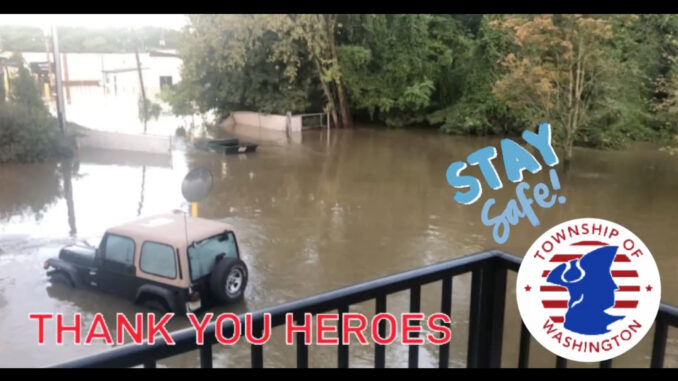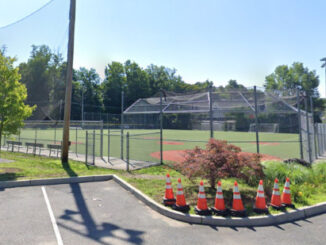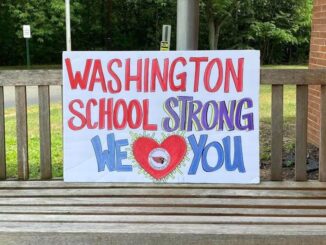
PASCACK VALLEY AREA—The Pascack Valley Mayors Association has written Bergen County Executive James Tedesco III to file for a FEMA grant “to assess flooding solutions that span waterways in the Pascack Valley.”
The letter, sent Oct. 5, is signed by Skip Kelley, executive director of the Pascack Valley Mayors Association; and Danielle DePaola of Emerson, John Ruocco of Hillsdale, Michael Ghassali of Montvale, John M. Kramer of Old Tappan, Dianne Didio of Oradell, Keith Misciagna of Park Ridge, Glen Jasionowski of River Vale, Peter Calamari of the Township of Washington, Ray Arroyo of Westwood, and Carlos Rendo of Woodcliff Lake.
The mayors say their communities’ efforts to contend with flooding along the Musquapsink, Pascack, Van Saun Mill, and other brooks has been “necessarily reactive,” centering on improving notice and communication, positioning rescue assets, assisting residents with clean up and hosting FEMA representatives who are facilitating the insurance claims process with property owners.”
But, they add, “The flooding we endure is a multifaceted problem, one that crosses municipal boundaries as well as the boundary between New Jersey and New York. Local attempts at mitigation, such as purchasing homes in the flood hazard zones or localized de-snagging and de-silting efforts, have been limited in scope and could not address the larger issue.”
They invite Tedesco to a PVMA dinner in Westwood on Oct. 13 to discuss the issue.
The mayors say that across their municipalities the number of homes purchased through Blue Acres has not removed enough impervious coverage to produce the area of absorption necessary to achieve significant flood reduction.
“Since the problem is a systemic, inter-municipal and interstate, one that involves cross-state water utilities, and the regulations governing them, we are requesting that Bergen County petition FEMA, to fund and conduct a holistic assessment of flooding along the length of the watershed, from its point of origin in NY state to the terminus of the Hackensack River,” they say.
The mayors say that when a disaster is declared and the federal government authorizes funding, only 20% of the total is set aside for Section 404 pre-hazard mitigation. “Competition for this funding pool is fierce. Projects are vetted and prioritized by the State, with those that survive the vetting process reviewed by FEMA for final approval and funding.”
The mayors say, “Individual Bergen County towns applying for these funds to address local pieces of a global problem may be less attractive to the reviewers than a request to study the interrelated pieces of the problem with an eye toward identifying, costing out and implementing more comprehensive, effective and durable mitigation methods.”
“Piecemeal local efforts,” the mayors say, “will necessarily leave most adversely impacted residents unsatisfied. Dredging the brooks along a handful of homes will increase flow and holding capacity along those properties. But the actual relief afforded by such limited efforts can only be as effective if similar, contemporaneous, and coordinated projects are implemented downstream.”
And they tell Tedesco, “Large scale home buyouts, even if grant funded, as in Morris County’s program (80 homes purchased demolished and restored to nature) inevitably have large-scale adverse tax revenue implications for county, municipal and school budgets.
“Therefore, requesting a comprehensive assessment study on mitigating flooding along the length of the brooks might be the beginning of truly understanding and addressing what our towns are up against.”
The mayors say such an assessment “would yield recommendations and provide a realistic cost benefit analysis of various inter municipal mitigation techniques. It would shed light on how the policies and procedures of the three dam operations along our interstate watershed impact local flooding events. And it would produce a document that we can share with our constituents to better inform their expectations.”
In their letter, the mayors note a U.S. Army Corps of Engineers Stage II study released in 1977, specific to the Pascack Brook portion of the Hackensack River Basin, concluded that there was “a federal interest to provide flood control measures along Pascack Brook.”
They note that while the study recommended that “a Stage III investigation be initiated to further study the flood problem and to develop flood control measures in more detail,” no additional investigation occurred.
“That recommendation is now over 40 years old. An almost half century of additional construction in and around the flood plains, severe repetitive flood damage; improved technology, science and engineering; as well as critical environmental and climate concerns, all point towards the need for an updated study,” say the mayors.
They acknowledge that climate change models agree “that our region will encounter wetter and more extreme weather events in the coming years. That eventuality might reasonably be expected to raise base flood elevations, expand current flood hazard zones, capture, and devalue more properties, put more Bergen County residents’ safety at risk, and reduce local tax revenues while escalating damage costs and insurance premiums.”
The leaders say, “We believe the PVMA’s request for a global assessment by FEMA is a timely one. Its conclusions may be sobering, but local policy makers and our constituents should have a clear understanding of this comprehensive problem.”
Moreover, they say, “It is a recurring endemic threat that cannot be effectively mitigated by local governments competing independently for grant monies that can only, and inadequately, address local flooding symptoms rather than its systemic causes.”



